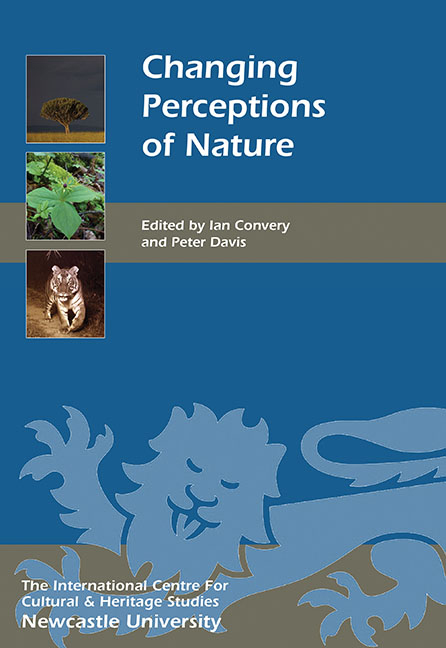Book contents
- Frontmatter
- Contents
- List of Illustrations
- Acknowledgments
- List of Abbreviations
- Foreword
- Introduction
- HISTORICAL PERSPECTIVES ON NATURE
- COLLECTING NATURE
- INTERPRETING NATURE AND LANDSCAPES
- CONSERVING NATURE
- PEOPLE–NATURE INTERACTIONS
- 22 Adventure, Nature and Commodification
- 23 Destination Nature: Wildlife and the Rise of Domestic Ecotourism in Britain, 1880–2015
- 24 Wild Places as Therapeutic Environments
- 25 Citizen Science and the Perception of Nature
- 26 Using Community-based Cultural Tourism to Enhance Nature Conservation in the Rupununi, Guyana
- 27 Representing Natural Heritage in Digital Space: from the National Museum of Natural History to Inuvialuit Living History
- 28 Out of the Wild Wood and into our Beds: the Evolutionary History of Teddy Bears and the Natural Selection of Deadly Cuteness
- 29 Rewilding: the Realisation and Reality of a New Challenge for Nature in the Twenty-first Century
- List of Contributors
- Index
- Miscellaneous Endmatter
28 - Out of the Wild Wood and into our Beds: the Evolutionary History of Teddy Bears and the Natural Selection of Deadly Cuteness
from PEOPLE–NATURE INTERACTIONS
Published online by Cambridge University Press: 26 October 2017
- Frontmatter
- Contents
- List of Illustrations
- Acknowledgments
- List of Abbreviations
- Foreword
- Introduction
- HISTORICAL PERSPECTIVES ON NATURE
- COLLECTING NATURE
- INTERPRETING NATURE AND LANDSCAPES
- CONSERVING NATURE
- PEOPLE–NATURE INTERACTIONS
- 22 Adventure, Nature and Commodification
- 23 Destination Nature: Wildlife and the Rise of Domestic Ecotourism in Britain, 1880–2015
- 24 Wild Places as Therapeutic Environments
- 25 Citizen Science and the Perception of Nature
- 26 Using Community-based Cultural Tourism to Enhance Nature Conservation in the Rupununi, Guyana
- 27 Representing Natural Heritage in Digital Space: from the National Museum of Natural History to Inuvialuit Living History
- 28 Out of the Wild Wood and into our Beds: the Evolutionary History of Teddy Bears and the Natural Selection of Deadly Cuteness
- 29 Rewilding: the Realisation and Reality of a New Challenge for Nature in the Twenty-first Century
- List of Contributors
- Index
- Miscellaneous Endmatter
Summary
The teddy bear, Brunus edwardii (Blackmore and Young 1972), has been a toy throughout Western Europe and North America since at least 1903. The popularity of teddy bears has ensured their continued survival while other cuddly toys have become extinct (eg Billy Possum), or waned in popularity (eg golliwogs, whose popularity declined sharply from the 1960s onwards due to perceived racism in the representation; Pilgrim 2012), or have been associated with short-lived fads, for example the Teletubbies. Teddy bears are disproportionately important in North American and European culture; ‘they concern our most intimate and deep-going feelings and experiences’ (Caldas-Coulthard and Van Leeuwen 2003, 26). They are intended to be played with and, perhaps even more importantly, cuddled and loved. Teddy bears are commonly portrayed as very important in the emotional lives of children, both as a significant resource to cuddle but also a consolation when adults do not give children sufficient time: they are seen as ‘commoditised sentimentality’ (Sutton-Smith 1986; Varga 2009a). Teddies are an important, but poorly researched, signifier in childhood studies (Nieuwenhuys 2011). Given their significance, the ecology of their interaction with humans reveals some remarkable natural history.
A striking feature of teddy bears is the variation in the predominant anatomical characteristics of manufactured bears throughout their roughly 110-year existence. The longevity of the teddy taxon, combined with their collectability, has preserved a wealth of detail about teddy bear morphology. There have been recorded changes to diversity and success, based on overall numbers (White 1971; Picot 1988), along with shifts in the frequency of anatomical forms (Picot 1988; Morris et al 1995; Nieuwenhuys 2011). Hinde and Barden (1985) presented evidence of changes in measurable morphology and suggested that these changes mimicked biological evolution. The changes to teddies are primarily a reduction in wild adult bear features (long limbs, long snouts, small heads) and an increase in juvenile bear and human baby characters (eg disproportionately large heads and short limbs), so-called neotenic – or infantile – anatomy. Similar evolutionary selection has been described for other children's toys, including Micky Mouse and Donald Duck (Gould 1980) and action figures where increased muscularity conforms to male body stereotypes (Pope et al 1999).
- Type
- Chapter
- Information
- Changing Perceptions of Nature , pp. 289 - 298Publisher: Boydell & BrewerPrint publication year: 2016

